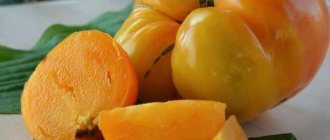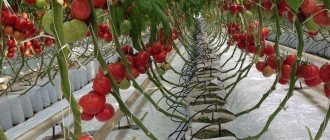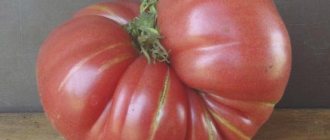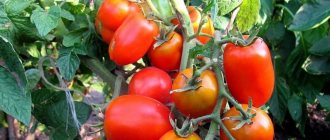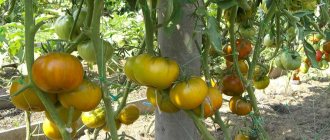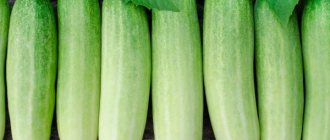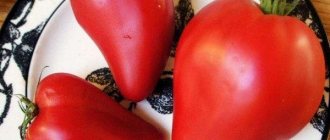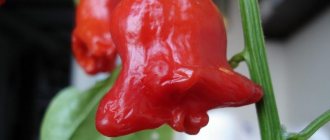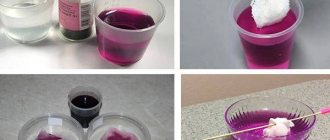The taste of the Hawaiian pineapple tomato will not leave any connoisseur of delicious vegetables indifferent. The variety quickly won the hearts of gardeners, surprising them with its unique taste sensations and excellent aroma.
| Height | Landing location | Ripening time | Fruit color | Fruit size | Origin | Fruit shape |
| Tall | Greenhouse | Mid-season | Yellow | Average | Variety | Flat-round |
Advantages and disadvantages
The main advantages of the Hawaiian pineapple tomato variety are:
- Mid-season fruit ripening.
- The plants are unpretentious to care and have excellent disease resistance.
- The fruits are large, juicy, fleshy with excellent taste.
- Plants are not afraid of temperature changes.
- Tomato seeds can be released and used for planting next year.
- Tomato fruits are universal in use.
The disadvantages are:
- Requirement of tomatoes in fertilizing.
- High growth.
- The need for regular tying and mulching of bushes.
Description and characteristics of the variety
In greenhouse conditions it produces a yield that is 2-3 times higher than ground crops. The variety is heat-loving, so its planting season begins in mid-May. The plant reacts very sensitively to the slightest temperature fluctuations, but grows and bears fruit well in greenhouses with proper care. It is distinguished by large, juicy, flat-round fruits weighing 300–700 grams, but under ideal conditions they can reach even 1.5 kg.
The tomato pulp has a classic tomato flavor, while the peel is reminiscent of kiwi or pineapple. Tradition with a spicy touch of exoticism combine perfectly and open up new facets of taste in summer salads and appetizers.
A unique feature of the tomato is the compactness of the bush, which, when properly formed, produces an abundance of fruit. The best option is a bush with two to three stems.
A rather tall plant requires careful monitoring of growth, gartering and installation of additional supports.
Growing rules
Hawaiian pineapple tomatoes are grown using the same method as other types of tomatoes. First, seeds are planted, seedlings are grown, and then they are transplanted into open ground or into a greenhouse. It is not difficult to achieve a high vegetable yield; the main thing is to carry out all the necessary care measures in a timely manner.
Preparing the soil for cultivation
It is known that tomatoes prefer sandy loam soils and do not take root well in acidic soil. In the fall, the proposed plot of land must be dug up and the necessary fertilizing in the form of mineral and organic compounds applied. In the spring, this procedure is repeated so that the soil is better enriched and future plants are sufficiently saturated with the necessary elements. To sow seeds, you should also prepare the ground. You can do this yourself, or purchase a ready-made substrate.
To prepare a mixture for growing tomatoes, the following components are often mixed:
- Wood sawdust.
- Superphosphate.
- A small amount of regular soil.
- Wood ash.
- It is also allowed to use potassium, nitrogen compounds and other fertilizers.
Before preparing the substrate, sawdust is soaked in water and then steamed in a solution of ammonium nitrate or potassium permanganate for disinfection. Then the remaining components are added, mixed and placed in containers, pots or special boxes.
Note! Containers for planting should have small holes to allow air exchange and avoid stagnation of liquid.
Tomato Hawaiian pineapple: characteristics and description of the variety, reviews
The Hawaiian pineapple tomato is a mid-season variety, is indeterminate and has excellent yield. Reviews and photos from gardeners confirm that growing tomatoes is easy; they take root well both in a greenhouse and in open ground.
The Hawaiian pineapple tomato is a widespread mid-season vegetable variety. The plant is indeterminate, its growth can reach more than 2 meters, which causes certain inconvenience in caring for it.
As a result of their high growth, tomatoes require regular care, namely tying, picking and forming bushes. The great demand for Hawaiian pineapple tomatoes among summer residents and gardeners lies in the fact that this variety is very productive and has some resistance to major dangerous diseases.
The characteristics of the vegetable are as follows:
- The bush grows large, with medium bushiness. The leaves are plentiful, they are ordinary tomato leaves with a rich green tint.
- The plant is very productive and not at all difficult to grow. It is enough for him to carry out basic care methods. But since the height is large, it is impossible to do without regular tying and mulching.
- The fruits are universal with an interesting color. The taste is sweet and sour, the flesh is juicy, fleshy, yellow or pale orange when cut. Tomatoes are great for preparing any dish, but are suitable for whole canning.
- Tomatoes can be stored for a long time if you follow the storage rules. They are moderately suitable for mechanical stress and can be used for transportation.
- There is excellent immunity to diseases and pests.
- Like other types of vegetables, the Hawaiian pineapple tomato is sensitive to watering and fertilizing.
Sowing seeds
Tomato seeds of the Hawaiian pineapple variety must be planted at the end of March or beginning of April, that is, 60-65 days before the intended transplantation of seedlings into open ground or a greenhouse.
Seeds are planted in pre-prepared containers with soil according to the following scheme:
- The soil is thoroughly moistened with warm water.
- Small furrows are made in the ground.
- The seeds are immersed in them sparingly.
- After planting, the containers are watered and placed in a room where there is optimal temperature, humidity and light.
In order not to waste your time in vain, the seeds can be pre-tested for suitability. To do this, they are lowered into the water and see which specimens float up, are removed, and those that remain at the bottom are used for planting.
Interesting! For fast and friendly growth of seedlings, seeds can be treated with growth preparations and disinfected with a manganese solution before growing.
Features of cultivation
Sowing seeds in a separate container with soil should be carried out 2 months in advance for the planned planting of bushes in the ground. As a rule, this concerns the beginning or middle of March. Full ripening of tomatoes occurs 100–110 days after the appearance of the first shoots. The optimal conditions for growing are considered to be greenhouses. The only exception may be open, well-lit garden plots in regions with a warm southern climate.
Bushes require obligatory pinching and careful tearing off of the lower leaves. In the process of tying to additional support, more attention must be paid to fixing the clusters with growing fruits. When planting bushes, you should maintain a distance of at least 50–65 cm. In this case, no more than three bushes can be planted per square meter of land, forming 2–3 stems.
To grow seedlings from seeds, you need a warm, bright room. The seeds are placed in the soil to a depth of no more than 1 cm. To make picking less painful and dangerous, the distance between the holes with seeds should be at least 1.7 - 2 cm. You can completely get rid of breaks in the root system when transplanting into permanent soil by planting the seeds in separate containers of 350 ml.
Important! Two days before transplanting the seedlings, it is necessary to thoroughly water the soil.
Loose fertilized soil, the temperature of which is not lower than 15 - 17 degrees Celsius, is suitable for replanting. When planting plants, warm water is used, as well as onion or garlic peels to protect the root system from possible damage by fungi or microbes. During the first week, it is important to water the bushes daily. After 10–15 days, it is important to carefully loosen the soil to ensure the roots are supplied with oxygen.
The mineral fertilizers used can be added along with watering no earlier than 15 - 20 days after planting. The frequency of supply with mineral complexes can be once every two to three weeks.
Transplanting seedlings
It is necessary to replant Hawaiian pineapple tomato seedlings in the afternoon; you should choose a time when the weather is clear and warm. This way the plants acclimatize faster and get used to new environmental conditions.
The area reserved for tomatoes should be thoroughly dug up and the necessary fertilizers applied. Afterwards, shallow holes are dug in a row. They are spaced 40 cm apart from each other, and an interval of 0.5 m is maintained between the rows. Seedlings are immersed in the resulting holes to almost half their length. Sprinkle earth on top and tamp lightly. After the beds are watered. To do this, it is better to use liquid at room temperature or slightly warmer.
Note! When replanting, many summer residents and gardeners recommend forming a bush of 2-3 stems.
Feeding and prevention
- Using modern complex fertilizers, it is possible to correct growth processes without the use of stimulants and genetic engineering.
- When fertilizers are added to the soil, dissolution occurs slowly; positive effects on plants appear within two years. These drugs are environmentally friendly. Residues in the fruits of uninhabited (=sparsely populated) tomatoes pose a health hazard.
- Biological products increase productivity, stimulate plant growth, and strengthen them.
The variety grows well in the middle zone, provided that all rules are followed and a greenhouse is available. The main thing is to wait until April to sow the seeds. By following the growing rules and carrying out a set of plant protection measures on time, you will be able to obtain a well-organized harvest of large, orange, very sweet Hawaiian pineapple tomatoes.
Care technology
In order to get a rich harvest of Hawaiian pineapple tomatoes in the summer, you need to provide at least minimal care for them. It involves timely transplanting of seedlings, watering plants, hilling the soil, and destroying weeds and pests. Also disease control, tying, mulching bushes and timely harvesting.
Water the tomatoes daily with water at room temperature. Water is directed only under the root system, avoiding contact of leaves and stems with it, in order to prevent the greenery from being burned by the sun's rays. It is also important to consider weather conditions when watering. If it rains, watering is skipped. On the contrary, in hot weather, plants are watered more intensively.
After watering, it is recommended to loosen the soil in the holes and remove weeds at the same time. Mulch and tie up the bushes as they grow, approximately every 2 weeks. For this purpose, supports, thread or special structures are used.
Diseases and pests are controlled through the use of insecticides, as well as through timely care of plantings.
Propagation from seeds
Tomato seeds are stored at a temperature of about 10 degrees in a dry place. If all conditions are met, they can protect their properties for up to 4 years. Temperatures below zero kill the super elite.
- Without stimulation, tomato seeds germinate in 10-12 days. Considering that growth and development can reach 100-110 days, it is better to intensify. Ant. slow down their pecking. The planting material is sorted, removing all deformed and small specimens, and therefore disinfected in a strong solution of potassium permanganate for 15 minutes.
- The seeds are kept at a temperature of 25 degrees until they hatch; the adhesive should remain moist.
- If planting in open regolith is intended, then hardening is also expected. To do this, the swollen moura are kept warm during the day - about 20 degrees - and put in the refrigerator at night (where the temperature is about 4-5 degrees). This regime should be maintained for 3-5 days. When the first shoots appear, the film is removed and the tar pot is moved to the windowsill. Compost made from plant residues is ideal for young plants.
- The Hawaiian pineapple variety, like all yellow varieties of tomatoes, is capricious in terms of transplantation. The root company is having a hard time recovering, which is affecting growth. Therefore, it is a wise decision to grow seedlings little by little in peat bags. In this case, it’s better to prepare the following mixture: for 8 parts of humus, take 2 parts of potassium, 1 part of mullein and 1 teaspoon each of superphosphate, potassium salt and urea.
- Before the early harvest, it is necessary to determine the time of planting. If aeroponics is planned in an unheated greenhouse or under a film, then the planting time is the end of February - beginning of March. It is allowed to sow mora at the end of March and after 30-35 days plant it in the planned area. The main thing is to have time to sow the seeds before April, otherwise the tomato will bloom too late and will not have time to ripen.
By mid-March, the seedlings should be strong. There should be 5-6 leaves. The pot is how to be big enough. It is better to water the seedlings in the evening hours.
Diseases and pests
If you care for tomatoes incorrectly, various diseases may appear. More often, Hawaiian pineapple tomatoes are affected by any form of rot, mosaic, late blight, black leg, spotting and other diseases.
Such conditions lead to disruption of growth and development, as a result of which the plants wither, the leaves dry out, turn yellow, curl and fall off. The fruits are also affected and the bush dies completely.
Frequent tomato pests include aphids, wireworms, mole crickets and other types of insects. They also negatively affect the overall development of tomatoes and can lead to their death.
Productivity
The excellent yield of the variety has been confirmed by numerous amateur gardeners. Their valuable experience shows the unpretentiousness and endurance of the tomato, even despite some difficulties in growing it. The need for many manipulations during the entire period of growth and ripening of vegetables does not stop gardeners and summer residents from planting plants.
The decorative qualities of the variety allow you to decorate both the garden bed and the dining table. The original bright color scheme, reminiscent of a ripe pineapple fruit with large pink streaks and darker reddish flesh, looks unusual in combination with dark streaks and orange-red peel.
Reviews
Elizaveta, 52 years old
“I am very pleased with growing the Hawaiian Pineapple tomato variety. The vegetables are mid-season, the fruits are large with excellent taste and beautiful color. The only drawback is its high growth, which requires frequent tying and shaping of the bush.”
Konstantin, 43 years old
“I have been growing Hawaiian pineapple tomatoes for 2 years in a row. I am very pleased with the harvest, the plants are unpretentious, the fruits are large and tasty. The tomato is resistant to diseases and stores well.”
Veronica, 39 years old
“The Hawaiian pineapple tomato is an excellent table variety of vegetable. The fruits are large, red-yellow, the number of seeds is medium; if desired, they can be left for planting. Tomatoes taste very good, so I use them for salads, juice, dishes and eat them fresh.”
Description of pineapple
A pineapple
This herbaceous plant belongs to the Bromeliad family (what a word!), which looks very unusual in appearance - bunches of hard leaves in the shape of a star, in the recess of which small flowers are clustered.
It is interesting that the inflorescences do not attract attention, but the leaves of such plants become bright and beautiful for several months during the flowering period.
For this reason, almost all Bromeliads are used as decoration in landscape design, and pineapple is practically the only edible representative of this family. Come on, admit it honestly: have you also thought for a long time that pineapples grow on palm trees?
